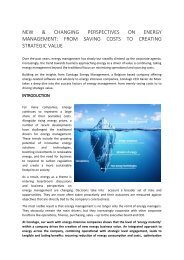Accurate Allocation of energy in production processes - the importance of using metamodels
Many companies struggle with correctly monitoring, allocating and distributing direct and indirect energy consumption over all internal and external customers, users or products. In this age of rising commodity costs and additional attention to sustainability, the advantages of adequately allocating energy are nonetheless substantial: 1. Real-time mapping of energy throughout process flows makes it easier to detect deviations in energy conversions during production processes, find the root causes and reduce losses. 2. Using exact and objective keys for allocating energy consumption speeds up periodic P&L and CSR reporting and makes for more accurate reports. 3. Continuous, real-time distribution of energy cost among users increases transparency and raises awareness with them. Although most companies already struggle with integrating correct data from metered equipment, this is only the first - albeit important - step. The crux is fully understanding the nature and efficiency of energy conversions processes; energy inflows and outflows to different customers; fixed and variable costs and corporate structures. By using metamodels - designed for and maintained by energy managers - all this information is added to the initial metered data and processed in such a way that any change from an energy point of view instantly leads to adjustments in the energy allocation. This white paper reviews emerging trends and challenges in energy allocation and examines the working and benefits of using specific metamodels at the level of energy management software.
Many companies struggle with correctly monitoring, allocating and distributing
direct and indirect energy consumption over all internal and external customers,
users or products. In this age of rising commodity costs and additional
attention to sustainability, the advantages of adequately allocating energy are
nonetheless substantial:
1. Real-time mapping of energy throughout process flows makes it easier
to detect deviations in energy conversions during production processes,
find the root causes and reduce losses.
2. Using exact and objective keys for allocating energy consumption
speeds up periodic P&L and CSR reporting and makes for more accurate
reports.
3. Continuous, real-time distribution of energy cost among users increases
transparency and raises awareness with them.
Although most companies already struggle with integrating correct data from
metered equipment, this is only the first - albeit important - step. The crux is
fully understanding the nature and efficiency of energy conversions processes;
energy inflows and outflows to different customers; fixed and variable costs
and corporate structures. By using metamodels - designed for and maintained
by energy managers - all this information is added to the initial metered data
and processed in such a way that any change from an energy point of view
instantly leads to adjustments in the energy allocation.
This white paper reviews emerging trends and challenges in energy allocation
and examines the working and benefits of using specific metamodels at the
level of energy management software.
You also want an ePaper? Increase the reach of your titles
YUMPU automatically turns print PDFs into web optimized ePapers that Google loves.
locally and <strong>the</strong>n used throughout <strong>the</strong> <strong>production</strong> process. In many cases <strong>the</strong>re<br />
will be conversions <strong>in</strong> between.<br />
Each submeter captures a part <strong>of</strong> this whole - and its place <strong>in</strong> it should be<br />
documented. This <strong>in</strong>volves both a specification <strong>of</strong> <strong>the</strong> type <strong>of</strong> <strong>energy</strong>/commodity<br />
it measures (electricity, gas, heat, compressed air,...) and <strong>the</strong> relationship to <strong>the</strong><br />
o<strong>the</strong>r meters. This way flows can be decomposed <strong>in</strong> <strong>the</strong>ir constituent parts and<br />
any losses/<strong>in</strong>efficiencies detected.<br />
Example graph based model with s<strong>in</strong>gle conversion<br />
Source node Distribution node Conversion node Distributionnode<br />
Natural gas grid<br />
Natural gas Hot water boilers Hot water<br />
connection<br />
S<strong>in</strong>k node<br />
Build<strong>in</strong>g product<br />
l<strong>in</strong>e 1<br />
S<strong>in</strong>k node<br />
Build<strong>in</strong>g product<br />
l<strong>in</strong>e 2<br />
Figure 1: Graph-based model example illustrat<strong>in</strong>g node types.<br />
Company structure<br />
Every meter ought to get a place <strong>in</strong> <strong>the</strong> overall company structure. They belong<br />
to departments, sites or build<strong>in</strong>gs. Groups <strong>of</strong> meters may toge<strong>the</strong>r capture <strong>the</strong><br />
<strong>energy</strong> situation <strong>of</strong> a part that is deemed relevant.<br />
Mapp<strong>in</strong>g <strong>the</strong> network <strong>of</strong> meters to <strong>the</strong> company structure is <strong>the</strong> bedrock for<br />
assign<strong>in</strong>g <strong>energy</strong> usage to cost centers throughout <strong>the</strong> company. Depend<strong>in</strong>g on<br />
<strong>the</strong> <strong>energy</strong> <strong>in</strong>tensity <strong>of</strong> <strong>the</strong> organisation, <strong>the</strong> impact on P&L can be considerable.<br />
A good metamodel captures this <strong>in</strong> a f<strong>in</strong>e gra<strong>in</strong>ed fashion, allow<strong>in</strong>g each<br />
<strong>in</strong>dividual meter to be clustered <strong>in</strong> several ways at <strong>the</strong> same time so as to<br />
reflect <strong>the</strong> complexity - and <strong>the</strong> peculiarities - <strong>of</strong> <strong>the</strong> company.<br />
Hierarchical model<br />
Company HQ<br />
Site Brussels<br />
Build<strong>in</strong>g 1<br />
L<strong>in</strong>e product A<br />
Build<strong>in</strong>g 2<br />
L<strong>in</strong>e product B<br />
L<strong>in</strong>e product C<br />
Site Antwerp<br />
Build<strong>in</strong>g 1<br />
L<strong>in</strong>e product D<br />
L<strong>in</strong>e product E<br />
Build<strong>in</strong>g 2<br />
L<strong>in</strong>e product F<br />
Site Ghent<br />
Build<strong>in</strong>g 1<br />
L<strong>in</strong>e product G<br />
L<strong>in</strong>e product H<br />
Build<strong>in</strong>g 2<br />
L<strong>in</strong>e product I<br />
Build<strong>in</strong>g 3<br />
L<strong>in</strong>e product J<br />
L<strong>in</strong>e pruduct K<br />
Figure 2: Hierarchical metamodel example for physical company structure<br />
10




